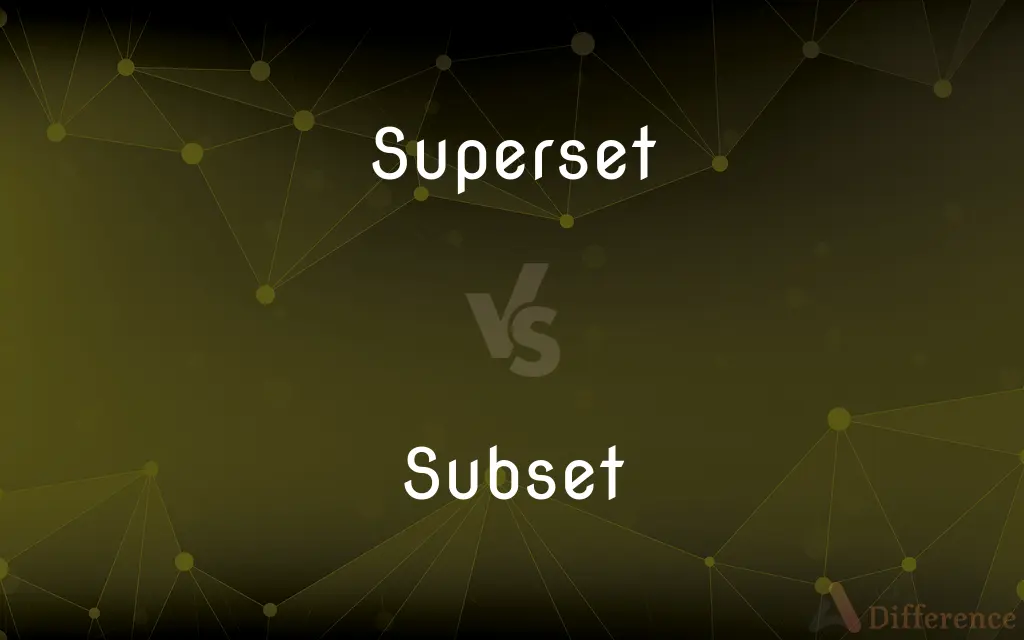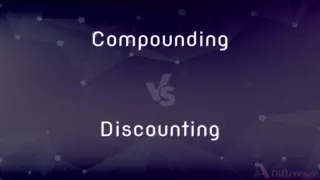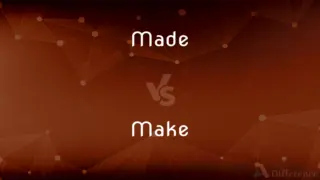Superset vs. Subset — What's the Difference?
By Tayyaba Rehman — Updated on November 3, 2023
A superset contains all elements of another set within it, while a subset is a set contained within another set.

Difference Between Superset and Subset
Table of Contents
ADVERTISEMENT
Key Differences
In the context of set theory, a superset is a set that includes all the elements of another set as well as possibly more. It is the larger set when comparing two sets where one contains the other. The term "superset" implies inclusivity and expansion beyond a basic group of elements. It's like an umbrella encompassing everything within a particular category, and then some.
A subset, on the other hand, is contained entirely within another set. It can be as small as having no elements (the empty set) or as large as the set itself. When you identify a subset, you are identifying a portion or a section of a whole, something that is part of a larger entity. Every set is a subset of itself, but to be a proper subset, it must have fewer elements than the set of which it is a part.
Supersets and subsets represent a relationship between sets that is foundational to set theory and mathematics as a whole. A subset is a concept of 'being part of,' or 'belonging to' a larger set, while a superset is a concept that extends this and 'encompasses' one or multiple subsets. While a superset speaks to a broad or more comprehensive grouping, a subset refers to specific, more limited groupings within that broad category.
For instance, in the set of all animals, the set of all birds is a subset, while the set of all animals is a superset to the set of all birds. This highlights the idea of hierarchy and inclusion within sets. A superset carries a more extensive collection of elements, while a subset is indicative of a selection or a part of this collection.
In summary, while a superset refers to a larger set containing other sets, a subset is a smaller component within a larger set. These concepts are not only critical to mathematics but also find metaphorical application in everyday language, where 'superset' may refer to a broad category and 'subset' may denote a specialized niche within that category.
ADVERTISEMENT
Comparison Chart
Definition
A set that contains all elements of another set.
A set contained entirely within another set.
Symbol
⊇ (represents "is a superset of")
⊆ (represents "is a subset of")
Implication of Quantity
Equal or greater number of elements.
Equal or lesser number of elements.
Relationship
Can have additional elements not in the subset.
Has no elements that are not in the superset.
Example
Set A = {1, 2, 3} is a superset of Set B = {2, 3}.
Set B = {2, 3} is a subset of Set A = {1, 2, 3}.
Compare with Definitions
Superset
A set that includes all elements of another set.
The set of all numbers is a superset of all integers.
Subset
A portion of a larger set.
The chess club is a subset of the school's extracurricular activities.
Superset
Any set that encompasses a given set completely.
The complete works of Shakespeare are a superset of his tragedies.
Subset
In mathematics, a set whose elements are all contained in another set.
The prime numbers form a subset of the natural numbers.
Superset
A larger set in which all the elements of a subset are contained.
The periodic table is a superset of the alkali metals.
Subset
A smaller set derived from a larger set.
The collection of science fiction novels is a subset of the library's book collection.
Superset
A broader category that contains subsets within it.
In fitness, a superset combines two exercises back-to-back with no rest.
Subset
A set contained within another set.
The set of squares is a subset of the set of rectangles.
Superset
In computing, an extension of a set with additional functionalities.
The programming language Python 3.x is a superset of Python 2.x, as it contains all its features and more.
Subset
Any set whose elements all belong to another set.
The group of red fruits is a subset of the fruit category.
Superset
(set theory) (symbol: ⊇) With respect to another set, a set such that each of the elements of the other set is also an element of the set.
The set of human beings is a superset of the set of human children.
The set of characters "LBPG" is a superset of the set of characters "PG".
Subset
In mathematics, a set A is a subset of a set B if all elements of A are also elements of B; B is then a superset of A. It is possible for A and B to be equal; if they are unequal, then A is a proper subset of B. The relationship of one set being a subset of another is called inclusion (or sometimes containment). A is a subset of B may also be expressed as B includes (or contains) A or A is included (or contained) in B. The subset relation defines a partial order on sets.
Superset
(weightlifting) Two or more different physical exercises performed back to back, without a period of rest between them. The exercises may employ the same muscle group, or opposing muscle groups.
Subset
A set contained within a set.
Superset
To perform (different physical exercises) back to back, without a period of rest between them.
Subset
A set A such that every element of A is also an element of S.
The set of integers is a subset of the set of real numbers.
The set is a both a subset and a proper subset of while the set is a subset of but not a proper subset of .
Subset
A group of things or people, all of which are in a specified larger group.
We asked a subset of the population of the town for their opinion.
Subset
(transitive) To take a subset of.
Subset
To extract only the portions of (a font) that are needed to display a particular document.
Subset
A set whose members are members of another set; a set contained within another set
Common Curiosities
How do you identify a subset?
A subset is identified by its elements all being contained within another set.
Can a set be a superset of itself?
Yes, every set is a superset of itself because it contains all its elements.
Can a set be a subset of itself?
Yes, every set is a subset of itself, but it is not a proper subset.
Is the empty set a subset or a superset?
The empty set is a subset of every set and a superset of itself only.
Can a superset have infinitely many subsets?
Yes, any set with at least one element has infinitely many subsets, including the empty set.
Does a subset always have fewer elements than a superset?
A proper subset does, but a subset can have the same number of elements if it is the set itself.
Can a set be both a subset and a superset at the same time?
Yes, a set is both a subset and a superset of itself.
What is the symbol for 'is a superset of'?
The symbol for 'is a superset of' is '⊇'.
In databases, what is a superset?
In databases, a superset refers to a larger dataset that contains smaller datasets or subsets.
What’s the difference between a proper and improper subset?
A proper subset has fewer elements than the set, while an improper subset, which can be the set itself, has the same number of elements.
What defines a superset?
A superset contains all elements of a particular set, and possibly more.
How does a subset relate to its superset?
A subset's elements are completely contained within its superset.
What is the symbol for 'is a subset of'?
The symbol for 'is a subset of' is '⊆'.
Can a set have more than one superset?
Yes, a set can have many supersets, including those that are larger or have additional elements.
In programming, what is a subset?
In programming, a subset can refer to a derived data structure that inherits properties from a larger structure, or it can refer to a limited set of features or functions from a library or framework.
Share Your Discovery

Previous Comparison
Compounding vs. Discounting
Next Comparison
Made vs. MakeAuthor Spotlight
Written by
Tayyaba RehmanTayyaba Rehman is a distinguished writer, currently serving as a primary contributor to askdifference.com. As a researcher in semantics and etymology, Tayyaba's passion for the complexity of languages and their distinctions has found a perfect home on the platform. Tayyaba delves into the intricacies of language, distinguishing between commonly confused words and phrases, thereby providing clarity for readers worldwide.













































